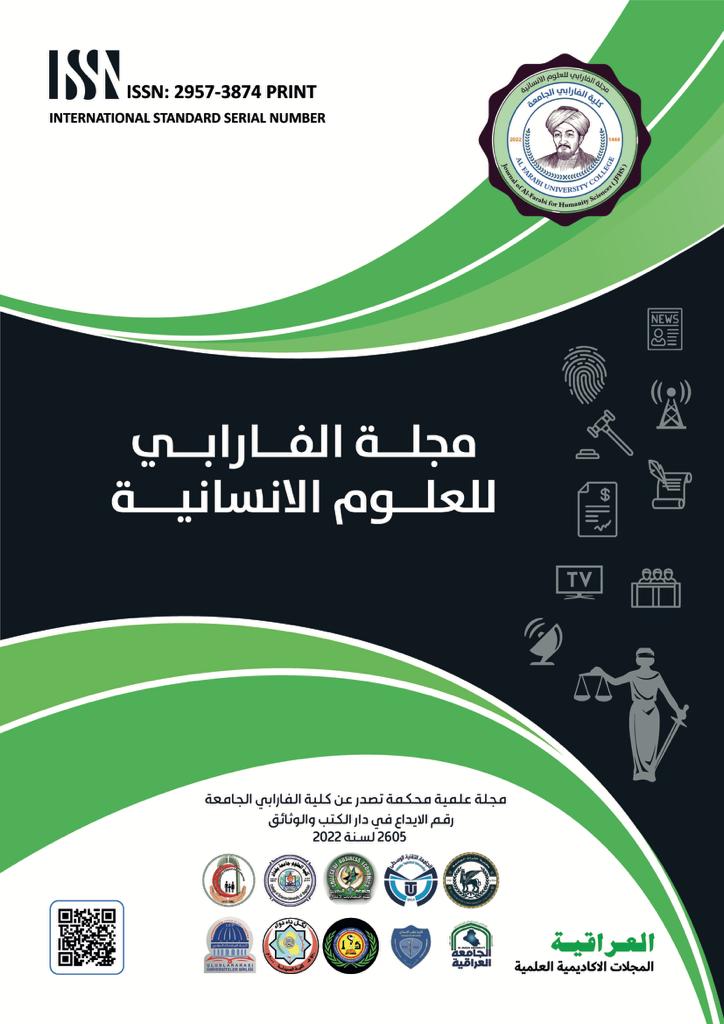الاختلاف في اللغة: الفروق الاكثر شيوعا بين لغة الذكور والاناث
DOI:
https://doi.org/10.59746/.v1i1.38الكلمات المفتاحية:
استخدام اللغة، الجنس، الاختلافالملخص
يسلط هذا البحث الضوء بشكل اساسي على الاختلافات بين اللغة والجنس، علاوة على ذلك فانه يعرض الاختلاف من وجهات النظر الصوتية والنحوية والمفردات في استخدام اللغة بين الذكور والإناث. كما نعلم أن اللغة هي أداة أو وسيلة اتصال يمكن للبشر استخدامها للتعبير عن أفكارهم ومشاعرهم ومشاركة أفكارهم. لذلك فإن الاختلاف الأكثر بروزًا بين البشر هو الاختلافات بين الجنسين. يختلف الذكور عن الإناث في حالتهم الفسيولوجية والنفسية، ولهما سمات جنسية خاصة بهما من حيث استخدام اللغة. في هذا البحث تم التحقق من العديد من الاختلافات والأسباب التي تكمن وراء الاختلافات في استخدام اللغة بين طلاب الدراسات الاولية في كلية خاصة في بغداد حيث تم إرسال استبيان إلكتروني إلى ثمانية وثمانين طالبًا لغرض الحصول على إجاباتهم. لقد تبين أن هؤلاء الطلاب لديهم العديد من الأسباب فيما يخص الاختلافات اللغوية بين الذكور والإناث.
المراجع
- Akhter, I. (2014). Differences in language use by male and female students in tertiary academia in Dhaka city. BRAC University.
- Cameron, D. (2003). 11. Gender Issues in Language Change. Annual review of applied linguistics, 23, 187-201. DOI: https://doi.org/10.1017/S0267190503000266
- Coates, J. (2015). Women, men and language: A sociolinguistic account of gender differences in language: Routledge. DOI: https://doi.org/10.4324/9781315835778
- Corson, D. (2001). Language Diversity and Education Lawrence Erlbaum Associates. Mahwah, New Jersey.
- Crawford, J. (1997). Best Evidence: Research Foundations of the Bilingual Education Act. NCBE Report.
- Crawford, M. (1995). Talking difference: On gender and language. Talking Difference, 1-224.
- Finch, G. (2017). Word of mouth: A new introduction to language and communication: Bloomsbury Publishing.
- Fishman, M. (1980). An Introduction to sociolinguistics. Malden: Blackwell publishing.
- Haas, A. (1979). Male and female spoken language differences: Stereotypes and evidence. Psychological Bulletin, 86(3), 616. DOI: https://doi.org/10.1037/0033-2909.86.3.616
- Holmes, J. (1986). Functions of you know in women's and men's speech. Language in society, 15(1), 1-21. DOI: https://doi.org/10.1017/S0047404500011623
- Holmes, J. (2008). An introduction to sociolinguistics: (pp. 52–73). England: Pearson Education Limited.
- Holmes, J. (2013). Women, men and politeness: Routledge. DOI: https://doi.org/10.4324/9781315845722
- Holmes, J., & Stubbe, M. (1997). Good listeners: Gender differences in New Zealand conversation. Women and Language, 20(2), 7.
- Holmes, J., & Wilson, N. (2017). An introduction to sociolinguistics: Routledge. DOI: https://doi.org/10.4324/9781315728438
- Küntay, A., Slobin, D., DI, S., Gerhardt, J., Kyratzis, A., & Guo, J. (1996). Social interaction, social context, and language.
- Lakoff, R. (1973). Language and woman's place. Language in society, 2(1), 45-79. DOI: https://doi.org/10.1017/S0047404500000051
- Lakoff, R. (1975). Language and Women's Place. New York, Hark: Harper & Row.
- Lakoff, R. (1975). Linguistic theory and the real world 1. Language Learning, 25(2), 309-338. DOI: https://doi.org/10.1111/j.1467-1770.1975.tb00249.x
- Mary, T. (1998). Language and Gender: An Introduction: Cambridge: Polity Press.
- Mulac, A., Bradac, J. J., & Gibbons, P. (2001). Empirical support for the gender-as-culture hypothesis: An intercultural analysis of male/female language differences. Human Communication Research, 27(1), 121-152. DOI: https://doi.org/10.1093/hcr/27.1.121
- Nemati, A., & Bayer, J. M. (2007). Gender differences in the use of linguistic forms in the speech of men and women: A comparative study of Persian and English. Language in India, 7(9), 1-16.
- Poynton, C. (1989). Language and gender: Making the difference: Oxford University Press, USA.
- Rubin, D. L. (2013). Composing social identity in written language: Routledge. DOI: https://doi.org/10.4324/9780203812099
- Sadiqi, F. (2003). Women, Gender and Language in Morocco. Leiden and Boston: Brill. Cerca con Google. DOI: https://doi.org/10.1163/9789047404378
- Sapir, E. (2021). Selected writings of Edward Sapir in language, culture and personality: University of California Press.
- Shuy, D. (1969). A cultural approach to male-female miscommunication. London:-1969.–88 p.
- Tannen, D. (1990). You Just Don't Understand: Women and Men in. Conversation. New York: Ballantine books.
- Trudgill, P. (2000). Sociolinguistics: An introduction to language and society: Penguin UK.
- Von Flotow, L. (2011). Translating women: University of Ottawa Press Ottawa.
- Wardaugh, R., & Fuller, J. (2015). An Introduction to Sociolinguistics, Seven Edition: West Sussex, UK: John Wiley & Sons, Inc.
- Wardhaugh, R., & Fuller, J. M. (2021). An introduction to sociolinguistics: John Wiley & Sons.
- Wenjing, X. (2012). Study on gender differences in English. Lecture Notes in Information Technology, 16, 218.
- Yaeger-Dror, M. (1998). Factors influencing the contrast between men's and women's speech. Women and Language, 21(1), 40.
- YAGUELLO, M. (1978). Les mots et les femmes, Paris, Payot. 202p. Coll.• Langages et sociétés-.
- Yule, G. (2020). The study of language: Cambridge university press.




